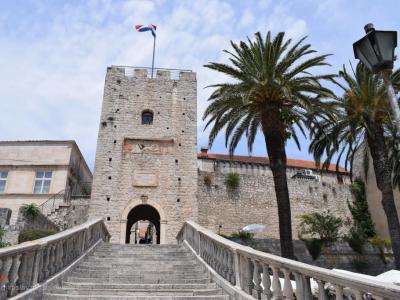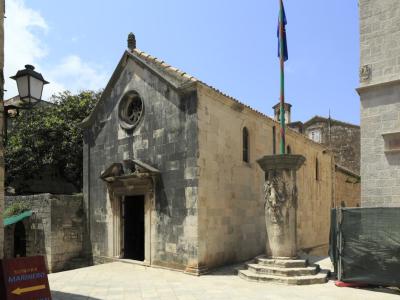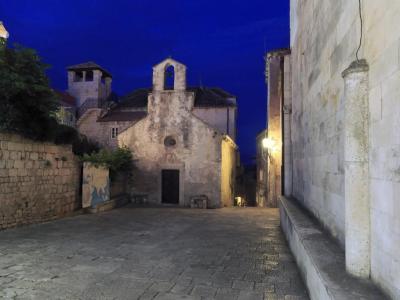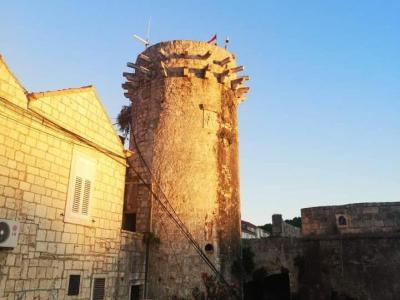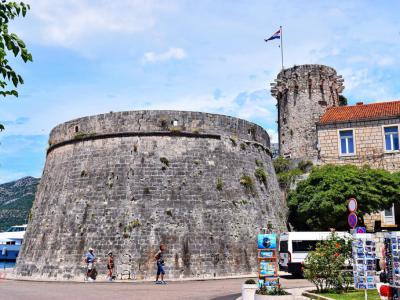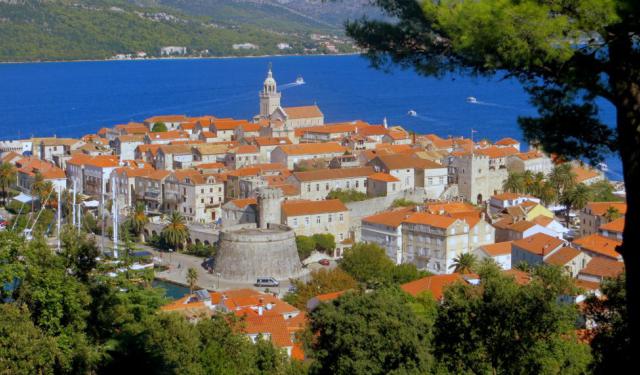
Korcula Introduction Walking Tour (Self Guided), Korcula
Korcula – pronounced as 'kor-chu-la' – is an enchanting destination nestled along the pristine coast of Croatia. One of the oldest cities on the Adriatic, it boasts a storied past reflecting its strategic location on a picturesque island of the same name. The history of the island itself is steeped in legend and conquest.
The town finds its roots in ancient history, with some speculating that it may have been founded by the Trojan hero Aeneas or his companion Antenor. A Greek colony on the island, established by settlers from Corfu in the 6th century BC, bore the name of "Black Corfu" (Melaina Korkyra), a moniker inspired by the island's dense pine forests. Subsequently, the island became part of the Roman province of Illyricum.
By the 6th century, Korcula fell under Byzantine rule, followed by Slavic invasions in the Great Migrations of the 6th and 7th centuries. Between the 12th and 15th centuries, it changed hands multiple times, governed by local Slavic rulers, Venice, Hungary, Genoa, and even enjoying a brief period of independence.
Locals claim that the renowned explorer Marco Polo was born in Korcula in 1254. In 1298, a pivotal naval battle occurred near the island, pitting the fleets of Genoa against Venice. Marco Polo may have participated in it on the Venetian side. The local Marco Polo House Museum offers a glimpse into his fascinating life.
After the Congress of Vienna, Korcula became Austrian territory in 1815, remaining so until it became part of Austria-Hungary in 1867. Shifting alliances in World War I and the aftermath placed the island under Italian rule and later Yugoslavia's authority. Finally, after Croatia's independence in 1991, Korcula became an integral part of the Republic of Croatia.
The abundance of historical sites in Korcula makes a one-day sightseeing here a bit challenging. Still, there are some sights not to miss. The Revelin Tower and Land Gate, guarding the town's entrance, are enduring symbols of its medieval past. As you explore the town's labyrinthine streets, the magnificent Cathedral of Saint Mark will captivate you with its ecclesiastical grandeur. Saint Peter's Church (Crkva Svetog Petra) stands as another architectural gem, a testament to Korcula's spiritual heritage.
The Korcula Town Walls, which during turbulent times provided protection, today add much to the town's picturesque charm.
These and other architectural treasures make Korcula a true gem on the Adriatic. Strolling along its cobbled streets, you can easily visualize the era of knights, merchants, and explorers. Added to the sun-soaked beaches and vibrant culture, all this promises a truly unforgettable experience!
The town finds its roots in ancient history, with some speculating that it may have been founded by the Trojan hero Aeneas or his companion Antenor. A Greek colony on the island, established by settlers from Corfu in the 6th century BC, bore the name of "Black Corfu" (Melaina Korkyra), a moniker inspired by the island's dense pine forests. Subsequently, the island became part of the Roman province of Illyricum.
By the 6th century, Korcula fell under Byzantine rule, followed by Slavic invasions in the Great Migrations of the 6th and 7th centuries. Between the 12th and 15th centuries, it changed hands multiple times, governed by local Slavic rulers, Venice, Hungary, Genoa, and even enjoying a brief period of independence.
Locals claim that the renowned explorer Marco Polo was born in Korcula in 1254. In 1298, a pivotal naval battle occurred near the island, pitting the fleets of Genoa against Venice. Marco Polo may have participated in it on the Venetian side. The local Marco Polo House Museum offers a glimpse into his fascinating life.
After the Congress of Vienna, Korcula became Austrian territory in 1815, remaining so until it became part of Austria-Hungary in 1867. Shifting alliances in World War I and the aftermath placed the island under Italian rule and later Yugoslavia's authority. Finally, after Croatia's independence in 1991, Korcula became an integral part of the Republic of Croatia.
The abundance of historical sites in Korcula makes a one-day sightseeing here a bit challenging. Still, there are some sights not to miss. The Revelin Tower and Land Gate, guarding the town's entrance, are enduring symbols of its medieval past. As you explore the town's labyrinthine streets, the magnificent Cathedral of Saint Mark will captivate you with its ecclesiastical grandeur. Saint Peter's Church (Crkva Svetog Petra) stands as another architectural gem, a testament to Korcula's spiritual heritage.
The Korcula Town Walls, which during turbulent times provided protection, today add much to the town's picturesque charm.
These and other architectural treasures make Korcula a true gem on the Adriatic. Strolling along its cobbled streets, you can easily visualize the era of knights, merchants, and explorers. Added to the sun-soaked beaches and vibrant culture, all this promises a truly unforgettable experience!
How it works: Download the app "GPSmyCity: Walks in 1K+ Cities" from Apple App Store or Google Play Store to your mobile phone or tablet. The app turns your mobile device into a personal tour guide and its built-in GPS navigation functions guide you from one tour stop to next. The app works offline, so no data plan is needed when traveling abroad.
Korcula Introduction Walking Tour Map
Guide Name: Korcula Introduction Walking Tour
Guide Location: Croatia » Korcula (See other walking tours in Korcula)
Guide Type: Self-guided Walking Tour (Sightseeing)
# of Attractions: 9
Tour Duration: 1 Hour(s)
Travel Distance: 0.5 Km or 0.3 Miles
Author: nataly
Sight(s) Featured in This Guide:
Guide Location: Croatia » Korcula (See other walking tours in Korcula)
Guide Type: Self-guided Walking Tour (Sightseeing)
# of Attractions: 9
Tour Duration: 1 Hour(s)
Travel Distance: 0.5 Km or 0.3 Miles
Author: nataly
Sight(s) Featured in This Guide:
- Revelin Tower and Land Gate
- Crkva Gospojina (Church of Our Lady)
- Korculanska Katedrala (Korcula Cathedral)
- Crkva Svetog Petra (St. Peter’s Church)
- Marko Polo Centar (Marco Polo Center)
- Kula Zakerjan (Zakerjan Tower)
- Korcula Town Walls
- Mala Knezeva Kula (Small Governor’s Tower)
- Velika Knezeva Kula (Large Governor’s Tower)
1) Revelin Tower and Land Gate (must see)
Еhe Revelin Tower stands as a timeless sentinel, inviting travelers to step through history. Dating back to the 13th century, this iconic structure, also known as the "Tower of the South Land Gate" it serves as the southern gateway into the Old Town, guarding the entrance with stoic grace.
Constructed from the island's indigenous stone, the Revelin Tower underwent meticulous restoration in 2003, restoring it to its former medieval grandeur. As visitors pass beneath the tower, they traverse a threshold that has witnessed centuries of history. The front facade proudly displays a lion relief sculpture, a nod to the town's Venetian heritage, echoing the era when Korcula was under Venetian rule.
Ascending to the top terrace of Revelin Tower, one is rewarded with breathtaking panoramas that stretch across the mesmerizing Strait of Pelješac, capturing the beauty of its archipelago and the intricate tapestry of Old Town rooftops. This vantage point not only provides a scenic spectacle but also offers a contemplative journey through the layers of time, from medieval tales to the island's pivotal moments, including its reunion with Croatia in the 20th century, commemorated by a plaque honoring the first Croatian king.
Beyond its architectural significance, Revelin Tower and the adjoining staircase are veritable time machines, inviting modern wanderers to tread the same path as those who, centuries ago, sought entry into the enchanting heart of Korcula.
Constructed from the island's indigenous stone, the Revelin Tower underwent meticulous restoration in 2003, restoring it to its former medieval grandeur. As visitors pass beneath the tower, they traverse a threshold that has witnessed centuries of history. The front facade proudly displays a lion relief sculpture, a nod to the town's Venetian heritage, echoing the era when Korcula was under Venetian rule.
Ascending to the top terrace of Revelin Tower, one is rewarded with breathtaking panoramas that stretch across the mesmerizing Strait of Pelješac, capturing the beauty of its archipelago and the intricate tapestry of Old Town rooftops. This vantage point not only provides a scenic spectacle but also offers a contemplative journey through the layers of time, from medieval tales to the island's pivotal moments, including its reunion with Croatia in the 20th century, commemorated by a plaque honoring the first Croatian king.
Beyond its architectural significance, Revelin Tower and the adjoining staircase are veritable time machines, inviting modern wanderers to tread the same path as those who, centuries ago, sought entry into the enchanting heart of Korcula.
2) Crkva Gospojina (Church of Our Lady)
In the heart of Korcula, the Church of Our Lady stands as an architectural jewel, echoing the prayers and devotion of centuries past. Constructed in 1483, this sacred edifice was dedicated to the celebration of the Immaculate Conception of the Virgin Mary. Initially serving as a chapel for the esteemed Gabrielis and Ismaelis families, the church radiates historical significance and spiritual grace.
The church's interior bears witness to the passage of time and the hands of artistic craftsmen. An altar, crafted in the 18th century, serves as a visual testament to the enduring commitment of the faithful. Additionally, the mosaics adorning the space behind the altar are a modern marvel, with Dutch artist Louis Schrikkela contributing his creative touch in the early 1960s.
As you approach the church, the impressive column on Saint Mark's Square commands attention. Erected in 1515, this large marble column stands proudly in the southwest corner of the square, an emblem of historical grandeur. Adorned with various coats of arms, the column is not merely a structural element but a testament to the rich tapestry of Korcula's heritage.
Extending skyward, the column transforms into a flag mast, proudly flying the flag of Korcula Town. The Church of Our Lady, with its harmonious blend of history, artistry, and religious significance, stands as a timeless symbol within the cultural fabric of Korcula.
The church's interior bears witness to the passage of time and the hands of artistic craftsmen. An altar, crafted in the 18th century, serves as a visual testament to the enduring commitment of the faithful. Additionally, the mosaics adorning the space behind the altar are a modern marvel, with Dutch artist Louis Schrikkela contributing his creative touch in the early 1960s.
As you approach the church, the impressive column on Saint Mark's Square commands attention. Erected in 1515, this large marble column stands proudly in the southwest corner of the square, an emblem of historical grandeur. Adorned with various coats of arms, the column is not merely a structural element but a testament to the rich tapestry of Korcula's heritage.
Extending skyward, the column transforms into a flag mast, proudly flying the flag of Korcula Town. The Church of Our Lady, with its harmonious blend of history, artistry, and religious significance, stands as a timeless symbol within the cultural fabric of Korcula.
3) Korculanska Katedrala (Korcula Cathedral) (must see)
The Cathedral of Saint Mark, affectionately known as Korčula Cathedral, stands as a sublime testament to architectural mastery and spiritual significance in the heart of Korčula, Croatia. Majestically positioned in the town center, this Roman Catholic cathedral unfolds a rich history woven by local craftsmen from the fifteenth century to the mid-sixteenth century.
As visitors approach, the cathedral's portal, a masterpiece crafted by Bonino da Milano, welcomes them into a realm of divine beauty. In 1557, the resonant notes of an organ filled the sacred space, signifying a musical addition to the cathedral's ambiance. The artistic legacy of Korčula Cathedral is further enriched by the masterful strokes of Tintoretto, who painted the altarpiece, adding a touch of Renaissance elegance to the sacred interior.
In 1787, a new organ, a testament to musical evolution, was crafted by the skilled hands of Vinko Klisevic. The cathedral's evolution did not halt with the passage of time. In the modern era, Croatian sculptor Frano Kršinić bestowed a bronze statue of Jesus Christ upon the baptistery, infusing contemporary artistry into the cathedral's timeless embrace.
The Cathedral of Saint Mark not only stands as an architectural marvel but also serves as a sacred repository of cultural and artistic treasures. It beckons both devout worshippers and admirers of history to bask in its spiritual aura and appreciate the harmonious fusion of artistic expressions across the ages.
As visitors approach, the cathedral's portal, a masterpiece crafted by Bonino da Milano, welcomes them into a realm of divine beauty. In 1557, the resonant notes of an organ filled the sacred space, signifying a musical addition to the cathedral's ambiance. The artistic legacy of Korčula Cathedral is further enriched by the masterful strokes of Tintoretto, who painted the altarpiece, adding a touch of Renaissance elegance to the sacred interior.
In 1787, a new organ, a testament to musical evolution, was crafted by the skilled hands of Vinko Klisevic. The cathedral's evolution did not halt with the passage of time. In the modern era, Croatian sculptor Frano Kršinić bestowed a bronze statue of Jesus Christ upon the baptistery, infusing contemporary artistry into the cathedral's timeless embrace.
The Cathedral of Saint Mark not only stands as an architectural marvel but also serves as a sacred repository of cultural and artistic treasures. It beckons both devout worshippers and admirers of history to bask in its spiritual aura and appreciate the harmonious fusion of artistic expressions across the ages.
4) Crkva Svetog Petra (St. Peter’s Church) (must see)
Nestled in the timeless embrace of Korcula's Old Town, Saint Peter's Church stands as a testament to centuries of faith and artistic expression. Dating back to the 14th century, this small Gothic church occupies a quaint square adjacent to the grand Cathedral, enriching the atmospheric tapestry of the historic surroundings.
The church's unassuming exterior belies the treasures within. A simple yet elegant facade, adorned with a relief of Saint Peter crafted by the skilled hands of Bonino da Milano, greets visitors as they step into this venerable sanctuary. Inside, the space is adorned with an open-beam ceiling, creating an intimate and serene atmosphere that invites contemplation.
Thirteen wooden Baroque statues of the Apostles and Evangelists grace the church's interior, each displayed on consoles along the walls. Crafted in the 18th century by an anonymous artist from Venice, these statues contribute to the church's aesthetic allure. The focal point, an altar crowned by the statue of Saint Peter, adds a spiritual dimension to the artistic ensemble.
Wandering through Saint Peter's Church, old gravestones underfoot serve as silent markers of the faithful who found solace in this sacred space. The tiny square that unfolds in front of the church, an extension of the main square, often becomes a stage for local artists, musicians, and poets, infusing the air with the lively spirit of creative expression. Saint Peter's Church, with its rich history and cultural resonance, remains a cherished gem within the enchanting embrace of Korcula's Old Town.
The church's unassuming exterior belies the treasures within. A simple yet elegant facade, adorned with a relief of Saint Peter crafted by the skilled hands of Bonino da Milano, greets visitors as they step into this venerable sanctuary. Inside, the space is adorned with an open-beam ceiling, creating an intimate and serene atmosphere that invites contemplation.
Thirteen wooden Baroque statues of the Apostles and Evangelists grace the church's interior, each displayed on consoles along the walls. Crafted in the 18th century by an anonymous artist from Venice, these statues contribute to the church's aesthetic allure. The focal point, an altar crowned by the statue of Saint Peter, adds a spiritual dimension to the artistic ensemble.
Wandering through Saint Peter's Church, old gravestones underfoot serve as silent markers of the faithful who found solace in this sacred space. The tiny square that unfolds in front of the church, an extension of the main square, often becomes a stage for local artists, musicians, and poets, infusing the air with the lively spirit of creative expression. Saint Peter's Church, with its rich history and cultural resonance, remains a cherished gem within the enchanting embrace of Korcula's Old Town.
5) Marko Polo Centar (Marco Polo Center)
The Marco Polo House-Museum in Korčula stands as a testament to the legendary explorer's supposed local roots. According to Croatian tradition, Marco Polo was born to a family of merchants and shipbuilders in Korčula before relocating to Venice. Historical records indicate the active involvement of the Polo family in the shipbuilding industry in Korčula during that period, with the name Depolo maintaining prominence in the town to this day.
The town itself is rich with references to Marco Polo, featuring establishments such as the Marco Polo hotel and restaurant, alongside numerous reminders in local shops. Each July, the Marco Polo Festival of Song and Wine takes place, celebrating the explorer, although the festival's connection with Marco Polo beyond the name remains somewhat elusive.
Tourists have the opportunity to explore the Marco Polo House, believed to be his birthplace, now converted into a small museum housing artifacts related to his travels. Of particular interest is the tower within the museum, providing panoramic views of the picturesque old town. Additionally, the International Marco Polo Centre, established in 1997, serves as a hub for studying Marco Polo's life and work, promoting tourism in Korčula, and fostering cultural ties between Europe and Asia.
The town itself is rich with references to Marco Polo, featuring establishments such as the Marco Polo hotel and restaurant, alongside numerous reminders in local shops. Each July, the Marco Polo Festival of Song and Wine takes place, celebrating the explorer, although the festival's connection with Marco Polo beyond the name remains somewhat elusive.
Tourists have the opportunity to explore the Marco Polo House, believed to be his birthplace, now converted into a small museum housing artifacts related to his travels. Of particular interest is the tower within the museum, providing panoramic views of the picturesque old town. Additionally, the International Marco Polo Centre, established in 1997, serves as a hub for studying Marco Polo's life and work, promoting tourism in Korčula, and fostering cultural ties between Europe and Asia.
6) Kula Zakerjan (Zakerjan Tower)
Zakerjan Tower, also known as Berim Tower, emerges proudly in the northern expanse of Korcula Town, bearing witness to the rich tapestry of its medieval past. Erected between 1481 and 1483 during the tenure of Giovanni Mocenigo, the Doge of Venice from 1478 to 1485, this tower stands as a testament to the strategic vision and architectural prowess of its time.
The tower's distinctive half-cylinder shape and crenellated crown evoke the medieval charm that graces Korcula's skyline. On the northern facade, facing the Peljesac Channel, the Venetian coat of arms of Governor Viaro and Doge Mocenigo proudly adorns the structure. Meanwhile, on the southern side, overlooking Korcula Town, the Tiepolo Coat of Arms above the arch adds a touch of Venetian elegance. Crafted by the skilled hands of Marko Andrijic and his local stonemasonry workshop, Zakerjan Tower stands as a living legacy of Korcula's architectural heritage.
In a delightful fusion of past and present, the tower now hosts the popular Massimo Bar. Accessing the bar involves a climb up a charming ladder leading to the turret, creating an adventure in itself. The pricing of the drinks aligns with the breathtaking panoramic views, and a clever pulley system ensures seamless delivery from the downstairs bar. The vistas from Bar Masimo's are unparalleled, making it a premier destination, especially for those seeking the quintessential Korcula experience.
The tower's distinctive half-cylinder shape and crenellated crown evoke the medieval charm that graces Korcula's skyline. On the northern facade, facing the Peljesac Channel, the Venetian coat of arms of Governor Viaro and Doge Mocenigo proudly adorns the structure. Meanwhile, on the southern side, overlooking Korcula Town, the Tiepolo Coat of Arms above the arch adds a touch of Venetian elegance. Crafted by the skilled hands of Marko Andrijic and his local stonemasonry workshop, Zakerjan Tower stands as a living legacy of Korcula's architectural heritage.
In a delightful fusion of past and present, the tower now hosts the popular Massimo Bar. Accessing the bar involves a climb up a charming ladder leading to the turret, creating an adventure in itself. The pricing of the drinks aligns with the breathtaking panoramic views, and a clever pulley system ensures seamless delivery from the downstairs bar. The vistas from Bar Masimo's are unparalleled, making it a premier destination, especially for those seeking the quintessential Korcula experience.
7) Korcula Town Walls (must see)
The Old Town of Korcula, cradled on the shores of the Adriatic, boasts a storied past, guarded by the formidable Korcula Town Walls. Strategically perched on the island, the town's medieval origins prompted the construction of robust defensive fortifications, transforming it into one of Croatia's most impressive surviving fortified medieval towns. The imposing remnants of these walls, with their towers, stand as sentinels, a testament to the architectural prowess of medieval European war strategies.
As one approaches Korcula from the north and the east, the commanding presence of the defensive walls captures the imagination. These walls, erected in the 13th and 14th centuries, were designed not only to shield the town's denizens from land-based threats but also to thwart incursions from the shimmering Adriatic. Over the centuries, as warfare evolved, so did the fortifications. From the early 18th century onward, advancements in weaponry prompted continuous enhancements and adjustments to the walls and towers.
However, as the threats of war waned and the town's way of life shifted, neglect gradually embraced these once vital defenses. By the early 19th century, large sections of the walls faced dereliction. In response to changing times and a visit by Franz Joseph I, Emperor of the Austro-Hungarian Empire, some portions, including the upper part of the eastern walls (Zakerjan area) and part of the western walls (Riva-Korcula port), were intentionally demolished. Despite these alterations, the Korcula Town Walls remain a formidable testament to a medieval era when the town's survival hinged on the strength of its protective embrace.
As one approaches Korcula from the north and the east, the commanding presence of the defensive walls captures the imagination. These walls, erected in the 13th and 14th centuries, were designed not only to shield the town's denizens from land-based threats but also to thwart incursions from the shimmering Adriatic. Over the centuries, as warfare evolved, so did the fortifications. From the early 18th century onward, advancements in weaponry prompted continuous enhancements and adjustments to the walls and towers.
However, as the threats of war waned and the town's way of life shifted, neglect gradually embraced these once vital defenses. By the early 19th century, large sections of the walls faced dereliction. In response to changing times and a visit by Franz Joseph I, Emperor of the Austro-Hungarian Empire, some portions, including the upper part of the eastern walls (Zakerjan area) and part of the western walls (Riva-Korcula port), were intentionally demolished. Despite these alterations, the Korcula Town Walls remain a formidable testament to a medieval era when the town's survival hinged on the strength of its protective embrace.
8) Mala Knezeva Kula (Small Governor’s Tower)
The Small Governor's Tower graces the South-West side of Korcula Town with its cylindrical silhouette. Constructed in 1449, this tower is alternatively referred to as Lombardo Tower, a nod to its builder, Governor Lombardo. Adorning one side of the tower is the intricately carved coat of arms of Governor Lombardo. Positioned just behind its larger counterpart, the Large Governor's Tower, Small Governor's Tower stands as a testament to the strategic construction of both towers, designed to safeguard the Governor's Palace.
9) Velika Knezeva Kula (Large Governor’s Tower)
The Large Governor's Tower, resembling a truncated cone, stands proudly in Korcula Town, having been erected in 1483. Locally known as "torjun," the tower exudes a sense of massiveness and strength. Commemorating the events of World War II, the tower features various plaques that pay tribute to the historical significance of the era.
Crowning the tower is a rounded crown ring, situated below the parapet, adding to its distinctive architectural profile. On the north-western side, facing the harbor, there was once a prominent plaque adorned with the Venetian lion and three coats of arms belonging to the Dukes Balbi, Contarinia, and Giorgio. Although the coats of arms were removed after World War II, replaced by an inscription honoring the town's liberation, the tower remains a symbolic testament to Korcula's history.
Constructed alongside the Small Governor's Tower in the 15th century, the Large Governor's Tower served a defensive purpose, safeguarding the Governor's Palace. Crafted from large, roughly shaped rectangular cubes, the tower's interior underwent a transformation in the early 20th century, repurposed for the storage of drinking water.
Crowning the tower is a rounded crown ring, situated below the parapet, adding to its distinctive architectural profile. On the north-western side, facing the harbor, there was once a prominent plaque adorned with the Venetian lion and three coats of arms belonging to the Dukes Balbi, Contarinia, and Giorgio. Although the coats of arms were removed after World War II, replaced by an inscription honoring the town's liberation, the tower remains a symbolic testament to Korcula's history.
Constructed alongside the Small Governor's Tower in the 15th century, the Large Governor's Tower served a defensive purpose, safeguarding the Governor's Palace. Crafted from large, roughly shaped rectangular cubes, the tower's interior underwent a transformation in the early 20th century, repurposed for the storage of drinking water.
The Most Popular Cities
/ view all
